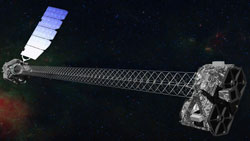NuSTAR Provides New Look at Black Holes

NuSTAR is the first telescope capable of focusing high-energy X-rays. It will also map supernova explosions and microflares on the surface of the sun. <br>
Ballantyne, one of the Institute’s black hole experts, is on the science team of NASA's Nuclear Spectroscopic Telescope Array (NuSTAR), which is now scheduled for launch Wednesday morning. He’s one of a handful of people who decided where the high-energy X-ray telescope will point while in orbit. NuSTAR’s technology will allow it to image areas of the universe in never-before-seen ways. Ballantyne will be among the first scientists to see the images and examine the data when it becomes available this later this summer.
“NuSTAR will provide a window to the murky world of black holes,” said Ballantyne, an assistant professor in the School of Physics. “The high-energy X-ray technology will allow us to see black holes that are buried deep inside their galaxies, hidden behind thick clouds of dust and gas. The goal is to unmask these black holes, study their host galaxies, and figure out how the black holes affect galaxy formation and evolution.”
Ballantyne has worked on the project, which is overseen by Fiona Harrison, a professor at the California Institute of Technology, since 2007. He and his peers have plotted three areas in the sky to survey, the largest of which spans approximately five full moons. Together, the surveys will uncover about 500 black holes, some of which have never been detected by any other telescope.
Seeing more means learning more, according to Ballantyne. He compares the study of black holes with learning about mankind.
“If you knew nothing about humans and looked at one person, you would quickly discover that we have two eyes, a nose and a mouth,” said Ballantyne. “But the deeper knowledge – traits such as aging, cultures – is only discovered by looking at a wide range of people. The more black holes we discover and study, the more we will understand about their roles in the cosmos.”
NuSTAR is the first telescope capable of focusing high-energy X-rays. It will also map supernova explosions and microflares on the surface of the sun. It is the first American high-energy telescope launched since 2008 and the last one for the foreseeable future. There are no other planned projects.
NuSTAR will lift off aboard an airplane in the South Pacific. The plane will then launch a Pegasus rocket, which will carry the telescope into orbit. Images and data should be available for Ballantyne and his colleagues about a month after liftoff. Selected images and science stories will be made available for the public throughout the mission.
NASA will host a news teleconference at 3 p.m. EDT today (June 11) to discuss the launch. For dial-in information, reporters must email their name, media affiliation and telephone number to J.D. Harrington at j.d.harrington@nasa.gov by 2 p.m.
NuSTAR is a Small Explorer mission led by the California Institute of Technology and managed by NASA's Jet Propulsion Laboratory, both in Pasadena, Calif., for NASA's Science Mission Directorate. The spacecraft was built by Orbital Sciences Corporation, Dulles, Va. Its instrument was built by a consortium including Caltech; JPL; the University of California, Berkeley; Columbia University, New York; NASA's Goddard Space Flight Center in Greenbelt, Md.; the Danish Technical University in Denmark; Lawrence Livermore National Laboratory, Calif.; and ATK Aerospace Systems, Goleta, Calif. NuSTAR will be operated by UC Berkeley, with the Italian Space Agency providing its equatorial ground station located at Malindi, Kenya. The mission's outreach program is based at Sonoma State University, Calif. NASA's Explorer Program is managed by Goddard. JPL is managed by Caltech for NASA.
For more information, visit http://www.nasa.gov/nustar and http://www.nustar.caltech.edu
Media Contact
All latest news from the category: Physics and Astronomy
This area deals with the fundamental laws and building blocks of nature and how they interact, the properties and the behavior of matter, and research into space and time and their structures.
innovations-report provides in-depth reports and articles on subjects such as astrophysics, laser technologies, nuclear, quantum, particle and solid-state physics, nanotechnologies, planetary research and findings (Mars, Venus) and developments related to the Hubble Telescope.
Newest articles

Security vulnerability in browser interface
… allows computer access via graphics card. Researchers at Graz University of Technology were successful with three different side-channel attacks on graphics cards via the WebGPU browser interface. The attacks…

A closer look at mechanochemistry
Ferdi Schüth and his team at the Max Planck Institut für Kohlenforschung in Mülheim/Germany have been studying the phenomena of mechanochemistry for several years. But what actually happens at the…

Severe Vulnerabilities Discovered in Software to Protect Internet Routing
A research team from the National Research Center for Applied Cybersecurity ATHENE led by Prof. Dr. Haya Schulmann has uncovered 18 vulnerabilities in crucial software components of Resource Public Key…





















